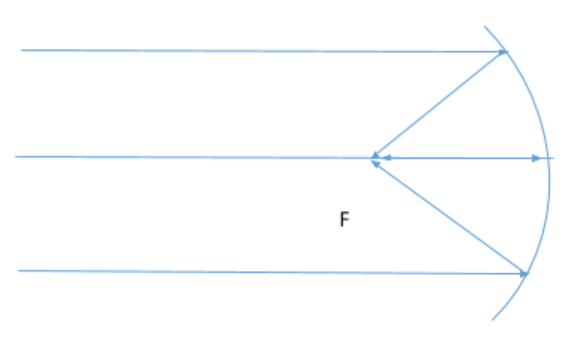
A converging mirror is a:
A. Plane mirror
B. Concave mirror
C. Convex mirror
D. Rear view mirror
Answer
590.7k+ views
Hint: Converging means focusing at a single point. Light gets converged when it reflects from the surface of a concave mirror whereas it gets diverged when it is reflected from the surface of a convex mirror.
Complete answer step by step:
A mirror which converges a parallel beam of light incident on its surface after reflection is called a converging mirror. A converging mirror focuses light at its principle focus. It must be a curved mirror which has reflection coating should be on its concave side. Therefore, a concave mirror is a converging mirror.

Answer- B. Concave mirror
Additional Information:
The concave and convex mirrors are two types of curved mirrors. Concave mirrors are used where we want to converge light and convex mirrors are used where we want to diverge the light. When light rays parallel to the principal axis coming from infinity fall on the surface of the concave mirror, it converges at a single point on the principal axis. This point is called ‘Principal Focus of concave mirrors. The principal focus is also referred to as simply focus or focal point. The concave mirror focal point lies in front of the mirror. The principal focus of convex mirrors lies behind the mirror therefore light appears to be diverging when it gets reflected from the convex mirror.
Note: Do not get confused between these two types of mirrors. Many times students get confused between convex and concave mirrors especially about their shapes. Simple way to remember their shapes is to remember their applications. It is easy to visualize their shapes once you understood their principle of working.
Complete answer step by step:
A mirror which converges a parallel beam of light incident on its surface after reflection is called a converging mirror. A converging mirror focuses light at its principle focus. It must be a curved mirror which has reflection coating should be on its concave side. Therefore, a concave mirror is a converging mirror.

Answer- B. Concave mirror
Additional Information:
The concave and convex mirrors are two types of curved mirrors. Concave mirrors are used where we want to converge light and convex mirrors are used where we want to diverge the light. When light rays parallel to the principal axis coming from infinity fall on the surface of the concave mirror, it converges at a single point on the principal axis. This point is called ‘Principal Focus of concave mirrors. The principal focus is also referred to as simply focus or focal point. The concave mirror focal point lies in front of the mirror. The principal focus of convex mirrors lies behind the mirror therefore light appears to be diverging when it gets reflected from the convex mirror.
Note: Do not get confused between these two types of mirrors. Many times students get confused between convex and concave mirrors especially about their shapes. Simple way to remember their shapes is to remember their applications. It is easy to visualize their shapes once you understood their principle of working.
Recently Updated Pages
Master Class 12 English: Engaging Questions & Answers for Success

Master Class 12 Business Studies: Engaging Questions & Answers for Success

Master Class 12 Economics: Engaging Questions & Answers for Success

Master Class 12 Social Science: Engaging Questions & Answers for Success

Master Class 12 Maths: Engaging Questions & Answers for Success

Master Class 12 Chemistry: Engaging Questions & Answers for Success

Trending doubts
What are the major means of transport Explain each class 12 social science CBSE

Which are the Top 10 Largest Countries of the World?

Draw a labelled sketch of the human eye class 12 physics CBSE

Explain sex determination in humans with line diag class 12 biology CBSE

Explain sex determination in humans with the help of class 12 biology CBSE

Differentiate between homogeneous and heterogeneous class 12 chemistry CBSE




